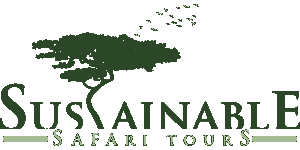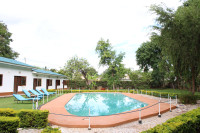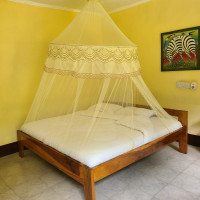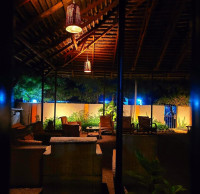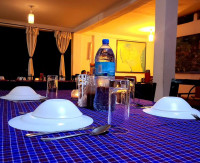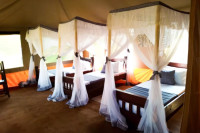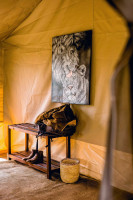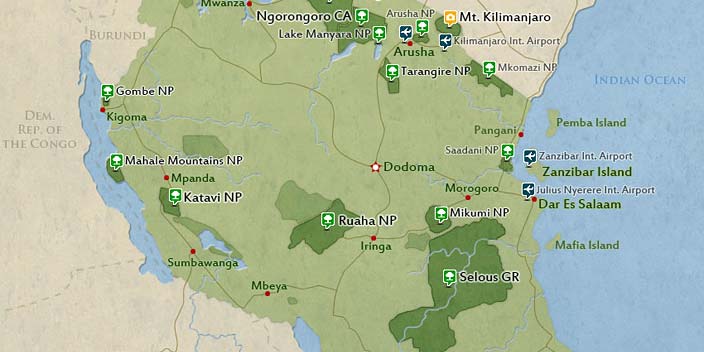
$1,210 to $1,232 pp (USD)
2 travelers on Start dateArrival
Arrival

Day 1
Arusha to Tarangire
Arusha to Tarangire
We will collect you from your hotel at 8:00 AM and begin your journey to one of Tanzania’s most remarkable national parks, Tarangire National Park. Renowned for its strikingly diverse landscape, the park encompasses nine distinct vegetation zones and is particularly noted for its majestic baobab trees, some of the largest and oldest on the African continent.
The park is home to a rich array of species, including over 500 bird species, as well as lions, leopards, zebras, giraffes, buffaloes, antelopes, and notably, elephants. In fact, Tarangire boasts the highest concentration of elephants in Tanzania, offering exceptional opportunities to witness their social behaviors up close.
Lunch will be served at a designated picnic site. Then you will enjoy an afternoon game drive before proceeding to your accommodation for the evening.
- Main Destination:
- Tarangire National Park
- Accommodation:
- Fig Lodge
- Meals & Drinks:

Day 2
Lake Manyara National Park
Lake Manyara National Park
A short yet scenic drive across the Great Rift Valley brings you to Lake Manyara National Park. The park is also home to a variety of other wildlife, including giraffes, elephants, impalas, and large herds of buffalo. The lake itself supports a significant population of hippos, while its shores are often adorned with flocks of flamingos. Game drives along the lake provide exceptional photographic opportunities, with iconic views of giraffes and buffaloes framed against the shimmering waters and vibrant birdlife.
Lake Manyara's landscapes are truly beyond description. For those seeking a more active experience, optional activities such as a guided bicycle tour or a boat excursion can be arranged during the day. In the afternoon, you will be transferred to your camp, where dinner will be served.
- Main Destination:
- Lake Manyara National Park
- Accommodation:
- Fig Lodge
- Meals & Drinks:

Day 3-4
Serengeti National Park
Serengeti National Park
After an early breakfast, we’ll set off toward the world-renowned Serengeti National Park. Our journey takes us up through the crater highlands, with a brief stop at the Ngorongoro Crater rim—offering an awe-inspiring panoramic view that will leave a lasting impression, especially for first-time visitors.
The Serengeti is the stage for one of nature’s greatest spectacles: the annual migration of over two million wildebeests, accompanied by hundreds of thousands of zebras and various antelope species such as impalas and Thomson's gazelles. The park is also a prime location for spotting predators like hyenas, lions, cheetahs, and leopards. Many iconic wildlife documentaries have captured unforgettable scenes—like the dramatic river crossings—right here in this extraordinary landscape.
- Main Destination:
- Serengeti National Park
- Accommodation:
- Engiterata Adventure Camps
- Meals & Drinks:

Day 5
Serengeti to Ngorongoro Conservation Area
Serengeti to Ngorongoro Conservation Area
We recommend an early wake-up to embark on a morning game drive—one of the best times to observe wildlife, as the animals are most active and the golden sunrise over the Serengeti is simply unforgettable. After the drive, we’ll return to camp for a well-earned brunch before continuing our journey to the Ngorongoro Crater, often referred to as the 8th Wonder of the Natural World.
It’s one of the few places on the continent where you may spot the critically endangered black rhino. The crater’s unique ecosystem features rivers, swamps, a soda lake frequented by flamingos, dense forests, and expansive grasslands. It’s also renowned for its enormous elephants, known for their impressively large tusks. A visit to the Ngorongoro Crater is truly an encounter with one of nature’s greatest masterpieces.
- Main Destination:
- Serengeti National Park
- Accommodation:
- Budget camping
- Meals & Drinks:

Day 6
Ngorongoro Crater to Arusha
Ngorongoro Crater to Arusha
We’ll begin the day early with a descend into the Ngorongoro Crater, where you'll enjoy a breathtaking morning of wildlife viewing in one of the most spectacular natural wonders on Earth. After the game drive, we’ll pause for a scenic picnic lunch near the serene hippo lake.
Following lunch, we’ll embark on a short final game drive before ascending the crater rim and making our way back towards Arusha. We anticipate arriving in Arusha around 5:00 PM, but we remain flexible in case of onward travel plans or other special arrangements.
- Main Destination:
- Ngorongoro Crater
- Accommodation:
- No accommodation (End of tour)
- Meals & Drinks:

